Making the right choice
Permanent hearing loss can occur from repeated overexposure to excessive noise. Damage can be prevented by wearing proper protection. Style, fit, and comfort over extended periods are important when selecting hearing protection.
Additional Factors to consider include
- Noise levels & exposure duration
- Compatibility with other protective equipment
- Equipment loss (if high, choose disposable; if low, choose reusables)
Types of Hearing Protection
Ear Plugs
Made from a variety of materials, and are positioned in the ear canal. Can be reusable or disposable and are available corded or uncorded. Designs include a simple canister shape and double or triple flanged models. A wide variety of colors aid in monitoring use and worker acceptance.
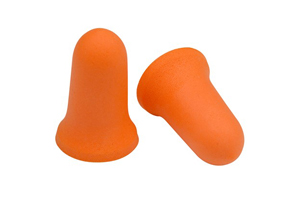
Disposable Ear Plugs
Single-use foam plugs that are rolled before insertion and conform to the shape of your ear canal.

Reusable Ear Plugs
Multiple-use ear plugs in a variety of materials such as foam and silicone. Often moldable, a soft multiple-flange shape, or include interchangeable tips for a more secure fit.
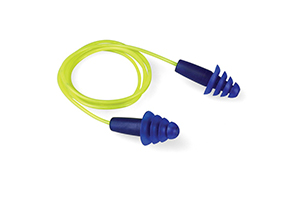
Corded Ear Plugs
Available in disposable or reusable formats, these are distinguished by having both ear plugs attached to a cord to make them more difficult to lose. This cord is sometimes detachable to prevent snagging.
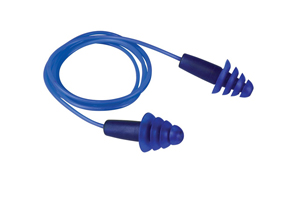
Metal Detectable Ear Plugs
Some ear plugs contain a metal component that can be quickly identified by metal detectors in case of loss while working in environments where contamination risk is present, such as food processing, pharmaceutical, and cosmetics factories.
Ear Muffs
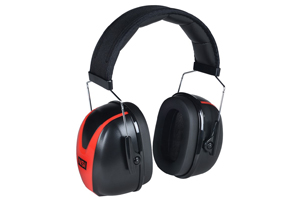
Ear Muffs
Cover and seal the entire ear. Sometimes worn in conjunction with plugs in high noise areas.
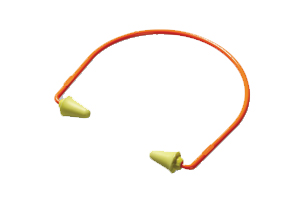
Banded Hearing Protectors
Flexible headbands for a comfortable seal. Offers several degrees of insertion for different levels of protection. Bright colors ensure easy compliance checks.
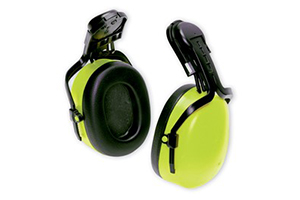
Hard Hat-Mounted Ear Muffs
For jobs requiring both head protection and hearing protection, ear muffs that can be mounted to a cap or hard hat are available. These can fit into headgear slots or be attached with a universal adapter mount.
How to Do a Fit Check
Hearing protection requires a proper fit to ensure the safest and most effective noise attenuation. Tools are available to test attenuation levels, but for everyday purposes it may be more practical to perform a fit test before working. Checking that your hearing protection is snug, fits properly, and blocking sound effectively will help you get the level of noise reduction you need to help prevent hearing loss.
- Ear Plugs
- Ear Muffs
While wearing ear plugs, count out loud while slowly cupping and uncapping your hands over your ears. If you have a good fit, your voice should sound about the same as you cup and uncup your hands.
While wearing ear muffs, pull your hair out of the way, adjust the ear cups so that they completely cover the ears, and adjust the headband.
More Information
OSHA 29 CFR 1910.132 provides general requirements for personal protective equipment and 29 CFR 1910.138 provides requirements for gloves.
Additional personal protective information is available through OSHA's Safety and Health Topics.
A wide variety of standards applies to gloves. The following are examples of some of the standards, regulations, or information that apply to gloves. Please note that additional standards and regulations could apply and would depend on your specific applications and uses of gloves.
- Voltage insulating and lineman's gloves information ANSI/ASTM D120-09, F696-06, F496-08, F1236-96(2007), Electrical Protective Devices OSHA 29 CFR 1910.137, OSHA eTools for PPE. NFPA 70E also provides standards for electrical safety
- Cut resistant gloves are generally covered under OSHA 29 CFR 1910.138. OSHA also provides an industry eTool for poultry processing and assistance for the meat packing industry.
- USDA accepted materials for glove components allowed for repeated use in a direct food contact zone must comply with the Federal Food, Drug, and Cosmetic Act (FFDCA)
The Noise Reduction System
Noise Reduction Rating (NRR) is the measure, in decibels, of how well a hearing protector reduces noise, as specified by the Environmental Protection Agency. The higher the number, the greater the noise reduction. When dual protectors are used, the combined NRR provides approximately 5 decibels more than the higher rated of the two products. For example, using ear plugs (NRR of 29 decibels) with ear muffs (NRR 27) would provide a Noise Reduction Rating of 34 decibels.
*Noise Reduction Ratings are listed within the product description for each hearing protector.
Examples of Noise Levels
The amount of on-the-job noise exposure can be determined through various testing devices. Excessive noise is defined as 85-90 decibels or more over an 8 hour period.
A sampling of noise levels is as follows:
- Normal Concentration - 60dB
- Sanding - 85dB
- Woodworking - 100dB
- Power Saw - 110dB
- Auto Traffic - 75dB
- Subway - 90dB
- Drilling (pneumatic) - 100dB
- Gunfire - 120dB
Federal Safety Standard
Please refer to OSHA General Industry Standard 29 CFR 1910.95, "Occupational Noise Exposure." Other relevant sections include 1926.52 and1926.101.
Related Links:
- OSHA website at https://www.osha.gov
- ANSI website at https://www.ansi.org
Call our knowledgeable Technical Support Department at 1-800-922-8553 or fill out the form below:


